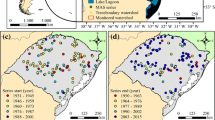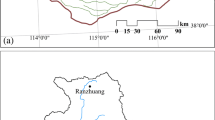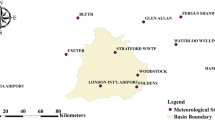Abstract
Long flood series are required to accurately estimate flood quantiles associated with high return periods, in order to design and assess the risk in hydraulic structures such as dams. However, observed flood series are commonly short. Flood series can be extended through hydro-meteorological modelling, yet the computational effort can be very demanding in case of a distributed model with a short time step is considered to obtain an accurate flood hydrograph characterisation. Statistical models can also be used, where the copula approach is spreading for performing multivariate flood frequency analyses. Nevertheless, the selection of the copula to characterise the dependence structure of short data series involves a large uncertainty. In the present study, a methodology to extend flood series by combining both approaches is introduced. First, the minimum number of flood hydrographs required to be simulated by a spatially distributed hydro-meteorological model is identified in terms of the uncertainty of quantile estimates obtained by both copula and marginal distributions. Second, a large synthetic sample is generated by a bivariate copula-based model, reducing the computation time required by the hydro-meteorological model. The hydro-meteorological modelling chain consists of the RainSim stochastic rainfall generator and the Real-time Interactive Basin Simulator (RIBS) rainfall-runoff model. The proposed procedure is applied to a case study in Spain. As a result, a large synthetic sample of peak-volume pairs is stochastically generated, keeping the statistical properties of the simulated series generated by the hydro-meteorological model. This method reduces the computation time consumed. The extended sample, consisting of the joint simulated and synthetic sample, can be used for improving flood risk assessment studies.











Similar content being viewed by others
References
Beven KJ (1987) Towards the use of catchment geomorphology in flood frequency predictions. Earth Surf Proc Land 12:69–82
Blazkova S, Beven KJ (1997) Flood frequency prediction for data limited catchments in the Czech Republic using stochastic rainfall model and TOPMODEL. J Hydrol 195:256–278
Blazkova S, Beven K (2004) Flood frequency estimation by continuous simulation of subcatchment rainfalls and discharges with the aim of improving dam safety assessment in a large basin in the Czech Republic. J Hydrol 292:153–172
Bonta JV, Rao AR (1988) Factors affecting the identification of independent storm events. J Hydrol 98:275–293
Boughton W, Droop O (2003) Continuous simulation for design flood estimation—a review. Environ Model Softw 18:309–318
Boughton W, Srikanthan S, Weinmann E (2002) Benchmarking a new design flood estimation system. Aust J Water Resour 6(1):45–52
Burton A, Kilsby C, Fowler H, Cowpertwait P, O’Connell P (2008) RainSim: a spatial-temporal stochastic rainfall modelling system. Environ Model Softw 23:1356–1369
Cabral MC, Garrote L, Bras RL, Entekhabi D (1992) A kinematic model of infiltration and runoff generation in layered and sloped soils. Adv Water Resour 15:311–324
Calver A, Lamb R (1995) Flood frequency estimation using continuous rainfall-runoff modelling. Phys Chem Earth 20:479–483
Cameron DS, Beven KJ, Tawn J, Blazkova S, Naden P (1999) Flood frequency estimation by continuous simulation for a gauged upland catchment (with uncertainty). J Hydrol 219:169–187
Candela A, Brigandì G, Aronica G (2014) Estimation of synthetic flood design hydrographs using a distributed rainfall–runoff model coupled with a copula-based single storm rainfall generator. Nat Hazard Earth Syst 14:1819–1833
Chebana F, Ouarda TBMJ (2011) Multivariate quantiles in hydrological frequency analysis. Environmetrics 22:63–78
Chetty K, Smithers J (2005) Continuous simulation modelling for design flood estimation in South Africa: preliminary investigations in the Thukela catchment. Phys Chem Earth 30:634–638
Chowdhary H, Escobar LA, Singh VP (2011) Identification of suitable copulas for bivariate frequency analysis of flood peak and flood volume data. Hydrol Res 42:193–216
Cowpertwait PS (1994) A generalized point process model for rainfall. Proc R Soc Lond A 447(1929):23–37
Cowpertwait PS (1995) A generalized spatial-temporal model of rainfall based on a clustered point process. Proc R Soc Lond A 450(1938):163–175
Cunnane C (1989) Statistical distributions for flood frequency analysis. World Meteorological Organization, Geneva, Switzerland, Operational Hydrology Report, pp 23–33
De Michele C, Salvadori G, Canossi M, Petaccia A, Rosso R (2005) Bivariate statistical approach to check adequacy of dam spillway. J Hydrol Eng 10:50–57
Eagleson P (1972) Dynamics of flood frequency. Water Resour Res 8(4):878–898
Engeland K, Xu C, Gottschalk L (2005) Assessing uncertainties in a conceptual water balance model using Bayesian methodology. Hydrol Sci J 50:45–63
England JF Jr, Velleux ML, Julien PY (2007) Two-dimensional simulations of extreme floods on a large watershed. J Hydrol 347:229–241
Favre AC, El Adlouni S, Perreault L, Thiémonge N, Bobée B (2004) Multivariate hydrological frequency analysis using copulas. Water Resour Res 40:W01101
Flores I, Sordo-Ward A, Mediero L, Garrote L (2013) Deriving bivariate flood frequency distributions for dam safety evaluation. In Proceedings of EWRA 2013: water resources management in an interdisciplinary changing context: Session 4, 93
Garrote L, Bras RL (1995a) A distributed model for real-time flood forecasting using digital elevation models. J Hydrol 167:279–306
Garrote L, Bras RL (1995b) An integrated software environment for real-time use of a distributed hydrologic model. J Hydrol 167:307–326
Genest C, Favre AC (2007) Everything you always wanted to know about copula modeling but were afraid to ask. J Hydrol 12:347–368
Genest C, Remillard B (2008) Validity of the parametric bootstrap for goodness-of-fit testing in semiparametric models. Annales De L’Institut Henri Poincare-Probabilites Et Statistiques 44:1096–1127
Genest C, Rivest L (1993) Statistical inference procedures for bivariate archimedean copulas. J Am Stat Assoc 88:1034–1043
Genest C, Ghoudi K, Rivest L (1995) A semiparametric estimation procedure of dependence parameters in multivariate families of distributions. Biometrika 82:543–552
Genest C, Quessy JF, Rémillard B (2006) Goodness-of-fit procedures for copula models based on the probability integral transformation. Scand J Stat 33:337–366
Genest C, Rémillard B, Beaudoin D (2009) Goodness-of-fit tests for copulas: a review and a power study. Insur Math Econ 44:199–213
Giustarini L, Camici S, Tarpanelli A, Brocca L, Melone F, Moramacro T (2010) Dam spillways adequacy evaluation through bivariate flood frequency analysis and hydrological continuous simulation. Conference proceedings of the Word Environmental and Water Resources Congress 2010: Challenges of Change, ASCE
Goel N, Seth S, Chandra S (1998) Multivariate modeling of flood flows. J Hydraul Eng-ASCE 124:146–155
GREHYS (1996) Presentation and review of some methods for regional flood frequency analysis. J Hydrol 186:63–84
Joe H (1997) Multivariate model and dependence concepts. Chapman and Hall, London
Klein B, Pahlow M, Hundecha Y, Schumann A (2010) Probability analysis of hydrological loads for the design of flood control systems using copulas. J Hydrol Eng 15:360–369
Kuchment LS, Gelfan AN, Demidov VN (2003) Application of dynamic-stochastic runoff generation models for estimating extreme flood frequency distributions. IAHS-AISH P 281:107–114
Lawrence D, Paquet E, Gailhard J, Fleig AK (2014) Stochastic semi-continuous simulation for extreme flood estimation in catchments with combined rainfall–snowmelt flood regimes. Nat Hazard Earth Sys 14:1283–1298
Mediero L, Garrote L, Martín-Carrasco F (2011) Probabilistic calibration of a distributed hydrological model for flood forecasting. Hydrol Sci J 56:1129–1149
Paquet E, Garavaglia F, Garçon R, Gailhard J (2013) The SCHADEX method: a semi-continuous rainfall–runoff simulation for extreme flood estimation. J Hydrol 495:23–37
Requena AI, Mediero L, Garrote L (2013) A bivariate return period based on copulas for hydrologic dam design: accounting for reservoir routing in risk estimation. Hydrol Earth Syst Sc 17:3023–3038
Requena AI, Chebana F, Mediero L (2015a) A complete procedure for multivariate index-flood model application. J Hydrol. (under review)
Requena AI, Prosdocimi I, Kjeldsen TR, Mediero L (2015b) A bivariate trend analysis to investigate the effect of increasing urbanisation on flood characteristics. Hydrol Res. (under review)
Restrepo-Posada PJ, Eagleson PS (1982) Identification of independent rainstorms. J Hydrol 55:303–319
Saad C, El Adlouni S, St-Hilaire A, Gachon P (2015) A nested multivariate copula approach to hydrometeorological simulations of spring floods: the case of the Richelieu River (Québec, Canada) record flood. Stoch Environ Res Risk Assess 29:275–294
Salvadori G, De Michele C (2004) Frequency analysis via copulas: theoretical aspects and applications to hydrological events. Water Resour Res 40:W12511
Salvadori G, De Michele C (2010) Multivariate multiparameter extreme value models and return periods: a copula approach. Water Resour Res 46:W10501
Salvadori G, De Michele C, Kottegoda NT, Rosso R (2007) Extremes in nature: an approach using copulas. Springer, Dordrecht
Salvadori G, De Michele C, Durante F (2011) On the return period and design in a multivariate framework. Hydrol Earth Syst Sc 15:3293–3305
Serinaldi F, Grimaldi S (2007) Fully nested 3-copula: procedure and application on hydrological data. J Hydrol Eng 12:420–430
Shiau J, Wang H, Tsai C (2006) Bivariate frequency analysis of floods using copulas. J Am Water Resour As 42:1549–1564
Sklar A (1959) Fonctions de répartition à n dimensions et leurs marges. Publ Inst Statist Univ Paris 8:229–231
Song S, Singh VP (2010) Frequency analysis of droughts using the Plackett copula and parameter estimation by genetic algorithm. Stoch Environ Res Risk Assess 24(5):783–805
Vandenberghe S, Verhoest NEC, De Baets B (2010) Fitting bivariate copulas to the dependence structure between storm characteristics: a detailed analysis based on 105 year 10 min rainfall. Water Resour Res 46:W01512
Vrugt JA, Bouten W, Gupta HV, Sorooshian S (2002) Toward improved identifiability of hydrologic model parameters: the information content on experimental data. Water Resour Res 38(12):48–1–48–13
Yue S, Ouarda T, Bobée B, Legendre P, Bruneau P (1999) The Gumbel mixed model for flood frequency analysis. J Hydrol 226:88–100
Zhang L, Singh VP (2006) Bivariate flood frequency analysis using the copula method. J Hydrol Eng 11:150–164
Zhang L, Singh VP (2007) Trivariate flood frequency analysis using the Gumbel–Hougaard copula. J Hydrol Eng 12:431–439
Zhang Q, Xiao M, Singh VP, Chen X (2013) Copula-based risk evaluation of hydrological droughts in the East River basin. China. Stoch Environ Res Risk Assess 27(6):1397–1406
Acknowledgments
This work has been supported by the Carlos González Cruz Foundation and the project ‘MODEX-Physically-based modelling of extreme hydrologic response under a probabilistic approach. Application to Dam Safety Analysis’ (CGL2011-22868), funded by the Spanish Ministry of Science and Innovation (now the Ministry of Economy and Competitiveness). The Authors would like to thank two anonymous reviewers for the useful comments provided to improve the quality of the paper.
Author information
Authors and Affiliations
Corresponding author
Rights and permissions
About this article
Cite this article
Requena, A.I., Flores, I., Mediero, L. et al. Extension of observed flood series by combining a distributed hydro-meteorological model and a copula-based model. Stoch Environ Res Risk Assess 30, 1363–1378 (2016). https://doi.org/10.1007/s00477-015-1138-x
Published:
Issue Date:
DOI: https://doi.org/10.1007/s00477-015-1138-x




